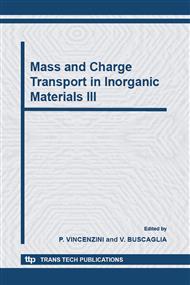p.11
p.21
p.27
p.32
p.42
p.48
p.54
p.63
p.73
Contribution to the Theory of Demixing of Yttrium in Yttria-Stabilized-Zirconia in an Electric Field
Abstract:
In this paper, the nature of steady state demixing of yttria-stabilized zirconia in an electric field is examined for the case of open system conditions (very fine grain material) wherein the defects are everywhere close to internal surfaces which allow the Schottky defect reaction to occur. It is shown that under such conditions the applied force needs to be some 20 -25 times larger than for the case of closed system conditions (Schottky defect reaction occurs only at the external surfaces) in order to achieve the same degree of demixing of the cation components. The effect of the constant electric field assumption as a substitute for the constant current condition is also analyzed for a wide range of applied electric fields. It is shown that in most cases, the assumption of a constant electric field provides only a moderate correction to the shape of the concentration profile.
Info:
Periodical:
Pages:
42-47
Citation:
Online since:
October 2006
Authors:
Price:
Сopyright:
© 2006 Trans Tech Publications Ltd. All Rights Reserved
Share:
Citation:


